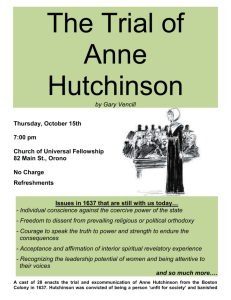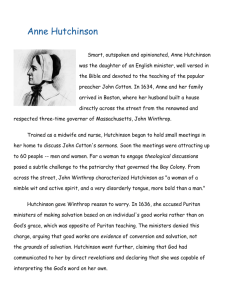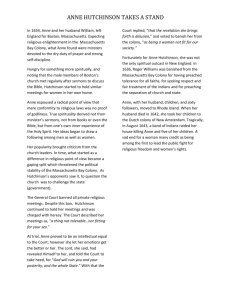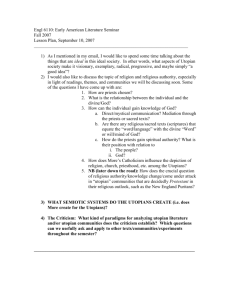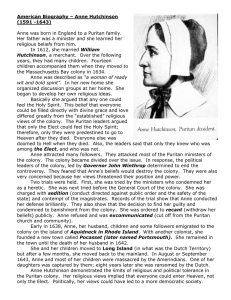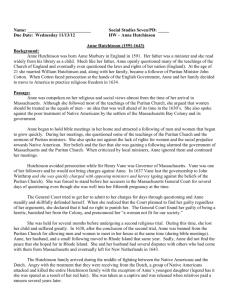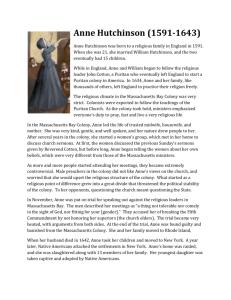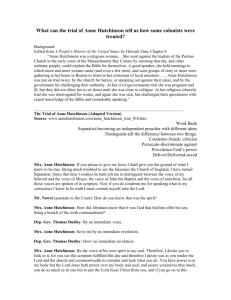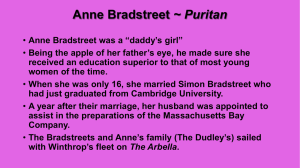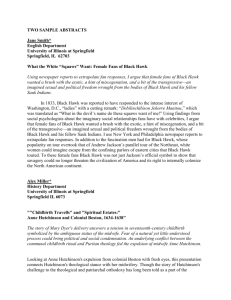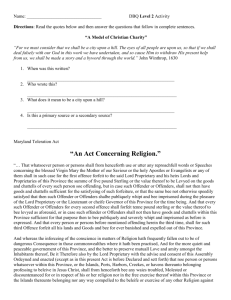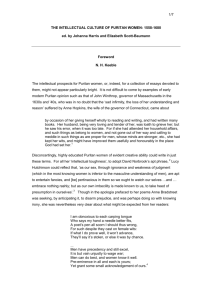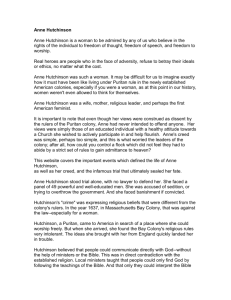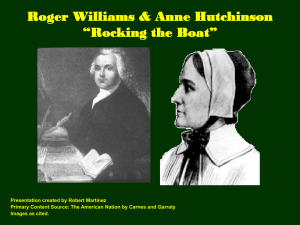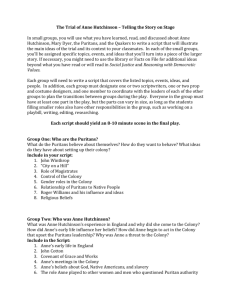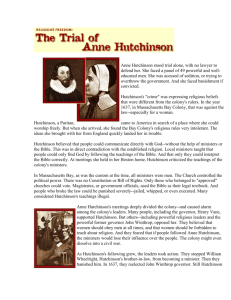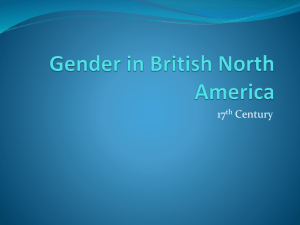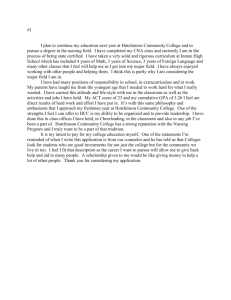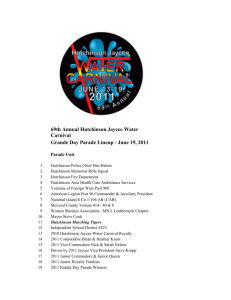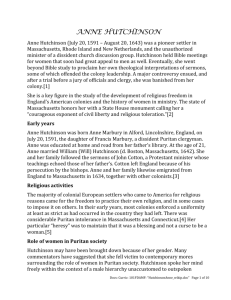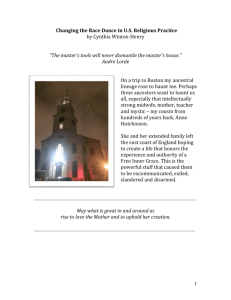StudySync-Puritans at Play and American Jezebel
advertisement
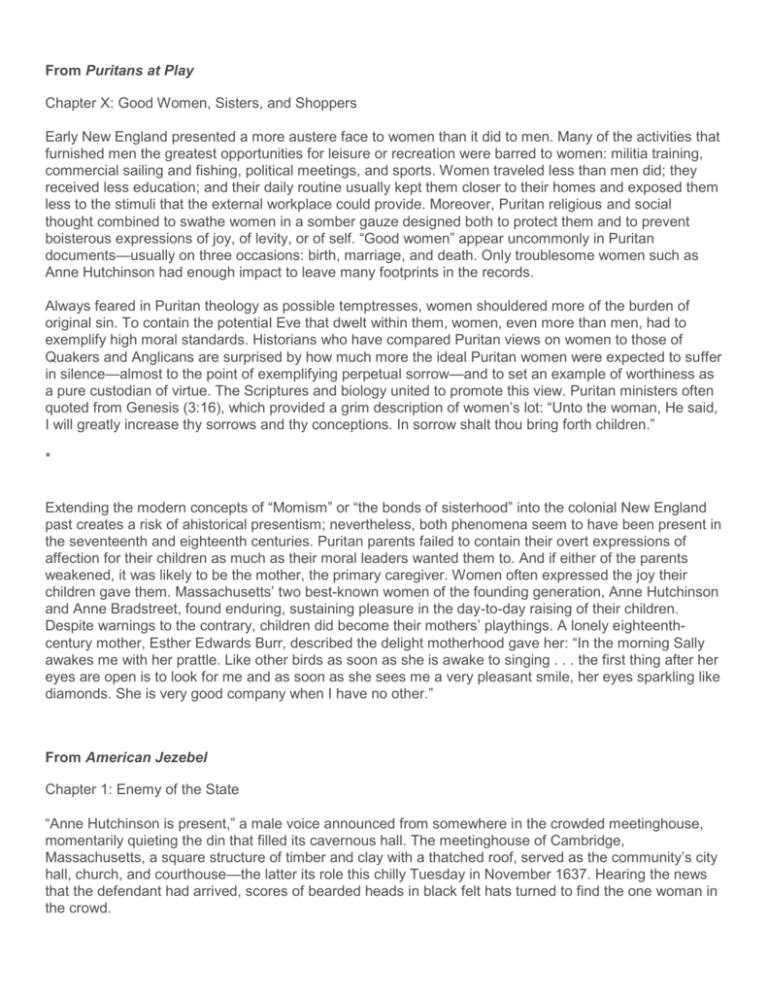
From Puritans at Play Chapter X: Good Women, Sisters, and Shoppers Early New England presented a more austere face to women than it did to men. Many of the activities that furnished men the greatest opportunities for leisure or recreation were barred to women: militia training, commercial sailing and fishing, political meetings, and sports. Women traveled less than men did; they received less education; and their daily routine usually kept them closer to their homes and exposed them less to the stimuli that the external workplace could provide. Moreover, Puritan religious and social thought combined to swathe women in a somber gauze designed both to protect them and to prevent boisterous expressions of joy, of levity, or of self. “Good women” appear uncommonly in Puritan documents—usually on three occasions: birth, marriage, and death. Only troublesome women such as Anne Hutchinson had enough impact to leave many footprints in the records. Always feared in Puritan theology as possible temptresses, women shouldered more of the burden of original sin. To contain the potential Eve that dwelt within them, women, even more than men, had to exemplify high moral standards. Historians who have compared Puritan views on women to those of Quakers and Anglicans are surprised by how much more the ideal Puritan women were expected to suffer in silence—almost to the point of exemplifying perpetual sorrow—and to set an example of worthiness as a pure custodian of virtue. The Scriptures and biology united to promote this view. Puritan ministers often quoted from Genesis (3:16), which provided a grim description of women’s lot: “Unto the woman, He said, I will greatly increase thy sorrows and thy conceptions. In sorrow shalt thou bring forth children.” * Extending the modern concepts of “Momism” or “the bonds of sisterhood” into the colonial New England past creates a risk of ahistorical presentism; nevertheless, both phenomena seem to have been present in the seventeenth and eighteenth centuries. Puritan parents failed to contain their overt expressions of affection for their children as much as their moral leaders wanted them to. And if either of the parents weakened, it was likely to be the mother, the primary caregiver. Women often expressed the joy their children gave them. Massachusetts’ two best-known women of the founding generation, Anne Hutchinson and Anne Bradstreet, found enduring, sustaining pleasure in the day-to-day raising of their children. Despite warnings to the contrary, children did become their mothers’ playthings. A lonely eighteenthcentury mother, Esther Edwards Burr, described the delight motherhood gave her: “In the morning Sally awakes me with her prattle. Like other birds as soon as she is awake to singing . . . the first thing after her eyes are open is to look for me and as soon as she sees me a very pleasant smile, her eyes sparkling like diamonds. She is very good company when I have no other.” From American Jezebel Chapter 1: Enemy of the State “Anne Hutchinson is present,” a male voice announced from somewhere in the crowded meetinghouse, momentarily quieting the din that filled its cavernous hall. The meetinghouse of Cambridge, Massachusetts, a square structure of timber and clay with a thatched roof, served as the community’s city hall, church, and courthouse—the latter its role this chilly Tuesday in November 1637. Hearing the news that the defendant had arrived, scores of bearded heads in black felt hats turned to find the one woman in the crowd. There was nothing auspicious about Anne Hutchinson’s appearance as she stood in the doorway alongside several male relatives and supporters, awaiting the start of the trial. She was forty-six years old, of average height and bearing, with an unremarkable face. Her petticoat fell almost to the ground, revealing only the tips of her leather boots. Against the cold she wore a wool mantua, or cloak. A white coif covered her hair, as was the custom of the day. Besides that and her white linen smock and neckerchief, she wore all black. She was a stranger to no one present, having ministered as midwife and nurse to many of their wives and children. All knew her to be an active member of the church of Boston, the wife of the wealthy textile merchant, William Hutchinson, the mother of twelve living children, and the grandmother of one, a five-day-old boy who just that Sunday had been baptized. There was, in short, no outward sign to show she was an enemy of the state. Enemy she was, though, indeed the greatest threat Massachusetts had ever known. More than a few men in the room, including several of the ministers, considered her a witch. Others believed the Devil had taken over her soul. The governor, John Winthrop, who was waiting in an antechamber of the meetinghouse to begin the trial over which he would preside, suspected her of using her devilish powers to subjugate men by establishing “the community of women” to foster “their abominable wickedness.” Anne Hutchinson’s greatest crime, and the source of her power, was the series of public meetings she held at her house to discuss Scripture and theology. At first, in 1635, the evening meetings had been just for women, who then were generally encouraged to gather in small groups to gossip and offer mutual support. Soon scores of women, enchanted by her intelligence and magnetism, flocked to hear her analysis of the week’s Scripture reading, which many of them preferred to the ministers’ latest interpretation. “Being a woman very helpful in times of childbirth and other occasions of bodily infirmities, [Hutchinson] easily inserted herself into the affections of many,” an official observed. Her “pretense was to repeat [the ministers’] sermons,: the governor added, “but when that was done, she would comment upon the doctrines, interpret passages at her pleasure, and expound dark places of Scripture, and make it serve her turn,” going beyond “wholesome truths” to “set forth her own stuff.” One minister, Thomas Weld, reported that her “custom was for her scholars to propound questions and she (gravely sitting in the chair) did make answers thereunto.” This was especially grievous in a time when the single chair in every house was for the use of the man alone. Men had begun to accompany their wives to Hutchinson’s meetings in 1636, and as her audiences swelled she offered a second session of religious instruction each week, just as the colonial ministers liked to give a Thursday lecture as well as their Sunday sermon. The Reverend Weld lamented that members of her audience, “being tainted, conveyed the infection to others,” including “some of the magistrates, some gentlemen, some scholars and men of learning, some Burgesses of our General Court, some of our captains and soldiers, some chief men in towns, and some eminent for religion, parts, and wit.” Anne Hutchinson had “stepped out of [her] place,” in the succinct phrase of the Reverend Hugh Peter, of Salem—she “had rather been a husband than a wife; and a preacher than a hearer; and a magistrate than a subject.” It was painfully clear to Governor Winthrop, who had an excellent view of her comings and goings from his house directly across the road from hers in Boston, that Anne Hutchinson possessed the strongest constituency of any leader in the colony. She was, he confided in his journal, “a woman of a haughty and fierce carriage, a nimble wit and an active spirit, and a very voluble tongue.” Her name was absent (on account of her sex) from every offensive political act and document, he observed, but she was behind them all. “More bold than a man,” she was Virgil’s dux foemina facti, “the woman leading all the action”— the breeder and nourisher of all the county’s distempers, the sower of political and religious discord. Before Mistress Hutchinson had arrived in America, in the fall of 1634, all was sweetness and light, he recalled. Now that she was here, all was chaos.
